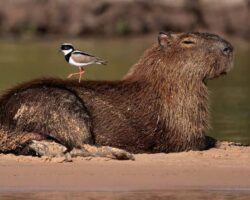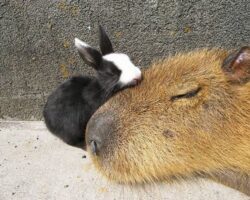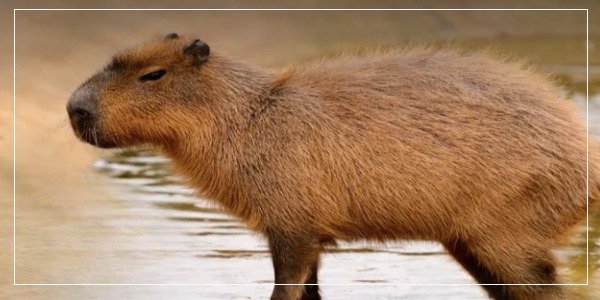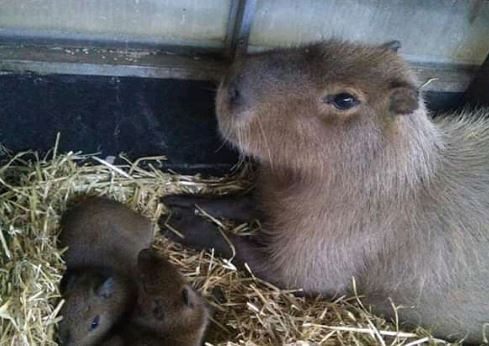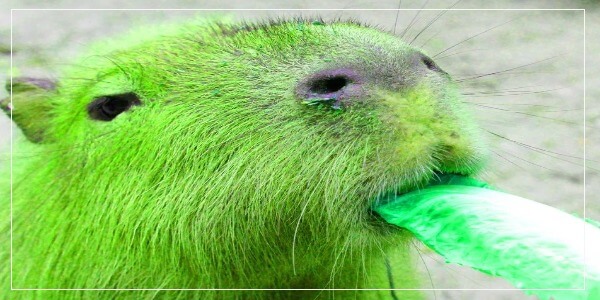The capybara is an animal belonging to the rodent family, just like mice, rats, guinea pigs, chinchillas, and squirrels. However, capybaras are big animals compared to their cousins. They can be huge and can weigh up to 65 kg!
The first mention of these animals comes from the second half of the 18th century. They were described by the famous Swedish naturalist Carl von Linne who classified them into the pig family.
So for a long time, capybaras were one of the pig’s species. That’s why it’s still being referred to as the Capybara today, a name that means grass-eating creature in the Guarani language.
Why Do Capybaras Like Baths?
Living near a pool or a water source is more of a necessity to the Capybara than a luxury. While it’s enjoyable to watch as it takes its warm bath, this rodent bathes for a more important reason than enjoying itself.
First, it takes a plunge to control its temperature. Capy’s love the equatorial climate, characterized by hot days and most nights. They can cool off in the heat because a scarce coat does not offer sufficient sun protection.
Capybaras usually do not leave the water at the hottest time of the day. Temperatures can rise to 40°C often. Since it has a thin layer of dry skin, it must take regular splashes to keep its temperature in check.
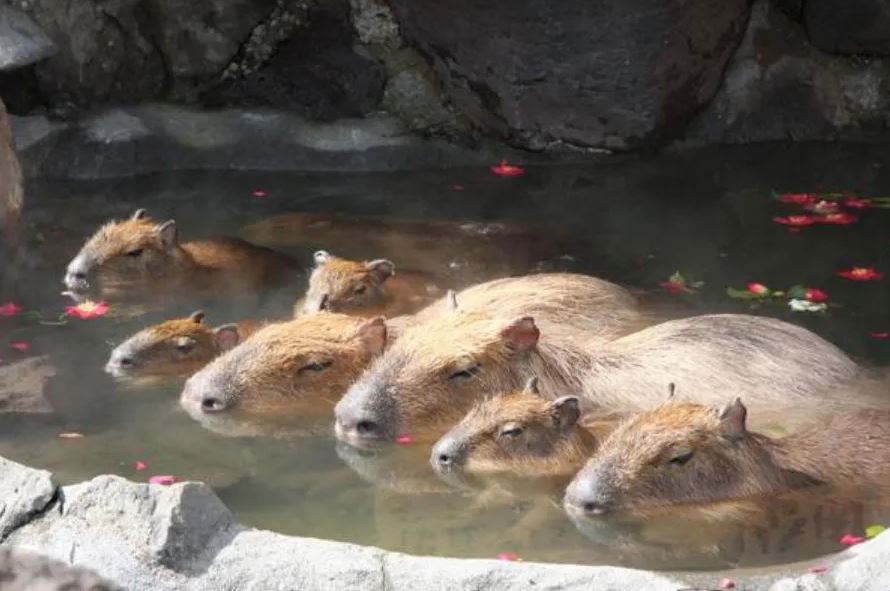
It’s also a perfect hiding place for them from predators. Think a puma (one of its biggest predators) comes after a capybara. It would jump into the water and swim away. Cats generally hate water, and the feline would retreat.
Also, Capybara mate in water. For Japan’s hot spring bathing, Capybaras, however, it is something more of temperature regulation than the other essentials. In the dead of winter, these animals naturally want something to give them warmth.
Why Are Capybaras in Hot Springs?
The only reason why Capybaras are in hot springs is to enjoy the warmth of the spring during Winter. Of course, they are a source of entertainment to the onlooking tourists or locals; the capybara is bathing only because it needs to get some warmth.
Japan experiences cold winters that are not conducive for rodents. So they built artificial hot baths that can mimic temperatures of the tropics, which the animals are accustomed to.
Do Capybara Like Hot Springs?
Yes!
If you have seen them in those hot baths or even seen a video, you will know that yes, they do like it!
Capybaras love water a lot! If you offer them water anywhere, anytime, they would appreciate it. To now offer them warm water in the cold of the winter, it’s like Christmas came early!
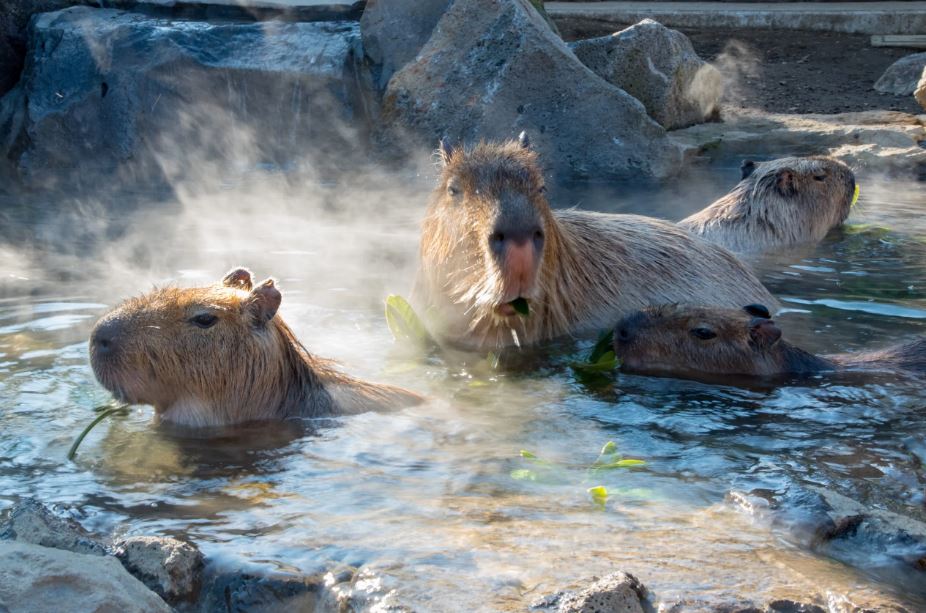
Capybaras are becoming a sensation in Japan, and it is because the animals do love what they do. They would lay back and relax and enjoy the warmth of the spring. This attitude that characterizes them over the years has made them a symbol of relaxation and peace.
What Climate Do Capybaras Prefer?
The natural habitat of capybaras is forests and savannas at more than 2,000 meters above sea level. They prefer tropical temperatures found in countries aligned along the Equator.
That’s why they enjoy warm baths in Japan’s hot springs. This gives them a feel of the temperatures of their true ‘home’.
They are found in Panama, Colombia, northeast Peru, part of Bolivia, Venezuela, Brazil, Uruguay, Paraguay, and northeast and east Argentina, predominantly in groups.
On his travels to South America, the scientist and explorer Charles Darwin described the behavior of capybara. This he wrote in 1832 when he met them on his visit to Maldonado (Uruguay):
During the day, they are stretched out among the aquatic plants, or they go quietly to graze the grass of the plain. Seen from a distance, their step and their color make them resemble pigs, but when they are seated, observing everything that happens, cavias and rabbits regain the appearance of their congeners. Towards noon, when the heat increases, they are submerged in the water until the temperature is regulated. of the body and fight, incidentally, external parasites.
What Animal Loves Hot Springs in Japan?
It’s not only the Capybara that loves to enjoy the warmth of a hot spring. Other animals have also shown interest in warm baths.
One is the Japanese Macaque, also known as the “Snow Monkey.” Snow monkeys could be found in winter bathing at the artificial hot baths in Jigokudani most times in a show for tourists and locals.
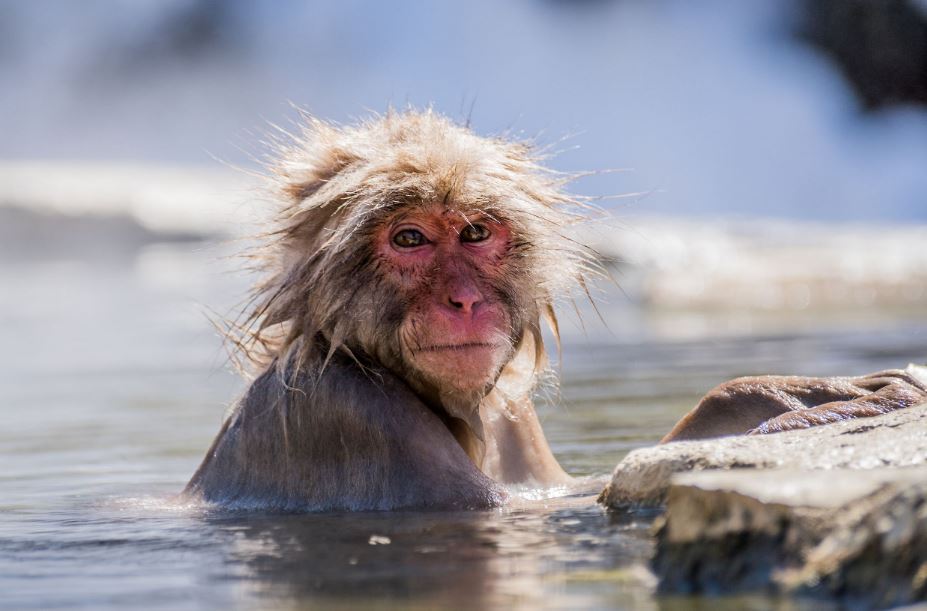
Snow Monkey bathing in hot springs has not started recently, though. The first monkey caught taking a deep happened far back as 1963.
Since then, the park has encouraged the Japanese Macaque to visit by making it more conducive. They even built a wider bath to that effect.
By 2003, a third of the female population was trooping around the bath. In deep cold winters, they have to fight for the chance to warm themselves in the springs.
And winter is a busy time for Jigokudani Park. It handles an average of 500 tourists who come to enjoy seeing the monkeys swim. Perhaps, mere watching them could lower human stress levels too. There is no scientific proof, but who knows.
READ MORE:
Capybara Hot Spring Competition
Capybara watching has become a sensational show in Japan, attracting more people per year. In the winter season, tourists and locals gather to watch the adorable animals enjoy themselves in the warmth.
This is so mind blogging and attractive that zookeepers created and organized an annual hot spring swimming completion. This competition is open to zoos nationwide and rewards the capybara, which spends the longest in the spring.
This year’s competition was held on January 9, and the champion was Cobbs, a capy from the Nasu Animal Kingdom. It won the championship after clocking for 1 hour, 44 minutes, and 36 seconds in the hot spring.
This is how it works. Participants would wait for the Capybara they chose to go into the water. Then the clock would start ticking. Different capybaras would enter at different times, so the clock wouldn’t necessarily start at the same time for every animal.
The animal with the longest duration gets the win.
Courtship Behavior and Life Cycle
According to the Animal Production portal, the capybara’s dependence on the aquatic environment includes the moment of courtship and copulation.
Capybara males, also known as “bucks,” have a shiny black sebum gland on the bridge of their noses, which produces a white syrup-like substance. This gland enlarges during the reproductive period. The bucks rub their gland on the stalks of plants so that the smell of secretion attracts a female.
When the male begins to chase the female, sniffing her and touching her genital region, she, without altering her gait and as if indifferent, guides her partner to a body of water, where they both bathe.
The female dives several times, disappearing from the surface and away from the male, who returns to look for her. Finally, and in shallow water (less than fifty centimeters), the male covers the female, who can submerge her head and raise her tail while she lets out short squeaks. The copulation is brief, just a few seconds.
Then they both swim and repeat it about fifteen times in a row and up to three in a minute. It is not uncommon for several couples to copulate at the same time and in the same body of water. And from time to time, they can exchange partners.
Occasionally, a female can interfere with a couple’s courtship, or a male disputes the female to another. After a gestation of between 122 and 153 days, the young are born in an advanced stage of development, and within a few days, they are in a position to follow their mother.
They formed families are maintained since the youngsters accompany their parents everywhere and even inactivity. That is why the capybara usually lives in sedentary herds of variable size, depending on the seasons.
The capybara, whose life cycle lasts around ten years, is already ready for procreation between a year and a half and two years old.
Capybara Can Be Pests Too!
Being animals, Capybara’s can be pests. They can feed on crops and ruin a farmer’s harvest. There was something that happened in Guillermo Hudson, in the province of Buenos Aires.
In a private neighborhood of that locality, the owners were tired of the problems the group of capybaras and geese that grew and reproduced in the areas were causing them.
The townspeople decided to drive the animals out of the town, leaving them on the other side of the bars. But they did not want to go and leave their home.
Social media came to their defense and even turned the capybaras into successful memes that reached all points of the internet.
Does Watching Capybaras Have a Healing Effect?
Very popular with adults to children all over Japan. Capybara, a rare beast, is loved as a healing system. Where is the secret of popularity? What came is the “Nasu Animal Kingdom”, where you can interact with capybaras.
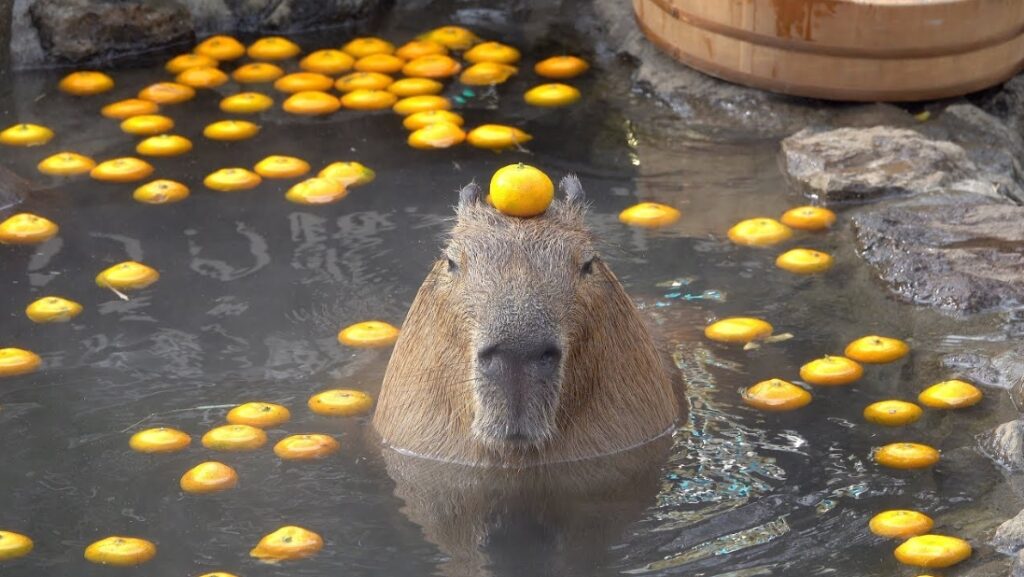
There was a capybara who comfortably entered the hot spring. The appearance of closing your eyes and soaking in hot water seems to be really comfortable.
According to Professor Akiyama of Tama Art University, Many of their customers say that Capybaras heal. That when you see a capybara, you are healed. Animals and characters that are cute and have healing effects have two characteristics:
One is that they have big head and are rounded. The second is that their eyes and mouths are closed.
For example, representatives studying healing systems, such as pandas and kittens, notice that these animals have large heads and rounded bodies, and their eyes and mouth are close to each other. This satisfies the characteristics of healing systems.
The capybara fulfills the first characteristic of the healing system, that the head is large and rounded. However, Capybara does not fit into the second feature. Capybara’s eyes and mouth are far apart.
Compared to pandas and kittens, the difference is clear! If anything, It’s more of a dumb feeling than cute. So is it true you can be healed by seeing capybaras?
If we investigate the brain waves, we can have a clue.
When a person is relaxed, the alpha wave values represented by light blue, green, and yellow are high. On the contrary, when you feel stressed, the value of the β wave shown in red becomes high.
Brain wave experts analyze the values of α and β waves, comparing the numerical value that they named “healing value”.
Eight men and women in their twenties to fifties have volunteered for their brain waves to be measured.
Eight people will see the zoo’s popular panda, a proposed healing animal. A kitten is very popular as a pet. A new standard capybara for healing and a crocodile
Healing sessions will be held with these animals. Can the Capybara’s waves beat the other animals? First of all, eight people saw the panda’s video. Next is a video of a kitten. Then the crocodile. The capybara wraps it off.
Results show the healing number value was highest in the kitten and a tie in the panda and the capybara, the crocodile didn’t have any score.
Why does a capybara, whose eyes and mouth are separated and do not fit into the healing characteristics, have a healing effect? According to experts, it’s because it has a behavior similar to that of humans.
“Taking a bath”, was the main point of Capybara’s popularity.
About 30 years ago, when Izu Shaboten Park in Shizuoka Prefecture unveiled capybaras that enter hot springs, the popularity of “hot spring capybaras” suddenly ignited, and now there are zoos where you can see capybaras bathing. There are more than 20 locations nationwide!
Conclusion
Capybaras are cute animals that have become a cultural sensation in Japan. Whenever you are in the land of the rising sun, make sure you visit one of those hot springs.





